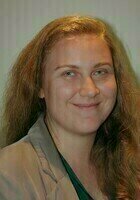All Genetics Resources
Example Questions
Example Question #221 : Genetics
Which method of DNA repair is used to correct damages caused by UV Radiation?
non-homologous end joint
nucleotide excision repair
mismatch repair
base excision repair
nucleotide excision repair
Nucleotide excision repair corrects DNA that turns into pyrimidine dimers. These are usually caused by ultraviolet radiation and result in sizable DNA adducts.
Example Question #221 : Genetics
What is the name for a mutation that occurs when one nucleic acid in the sequence is switched with another?
Insertion
deletion
frame shift
point mutation
point mutation
Point mutations occur when one nucleic base is swapped for a different nucleic base.
Example Question #222 : Genetics
If a nucleic acid is added into the RNA sequence, what type of mutation is this?
point mutation
addition
deletion
insertion
insertion
It is an insertion because a nucleic acid was added to the sequence.
Example Question #11 : Dna Mutations, Damage, And Repair Mechanisms
Which of the following represents a transition mutation in the following strand?
ATGCTGCAAGTA
ATGTCTGCAAGTA
ATGTCGCAAGTA
AGGCTGCAAGTA
ATGCTCCAAGTA
ATGCTGCCAGTA
ATGCTCCAAGTA
A transition mutation represents a purine-to-purine mutation or a pyrimidine-to-pyrimidine mutation. This could be a change of A to T, or vice versa. It could also be a change of C to G, or vice versa. Remember, a transition mutation does not insert or delete any bases. It simply changes a base.
Example Question #11 : Dna Mutations, Damage, And Repair Mechanisms
Which of the following mutation would be most deleterious?
An insertion of one base in an intron
Deletion of one base int he 3'UTR
A change of one base in the wobble position in a coding region of mRNA
Insertion of three bases in a coding region of mRNA
A insertion of two bases in the splice site
A insertion of two bases in the splice site
The most deleterious mutation would be a frameshift mutation. This would attained by inserting or deleting multiples of 1 or 2 bases in any important coding regions (exons, splice site, translation start site). Inserting or deleting multiples of 3 bases would not cause a frameshift mutation. A mutation in 3' UTR or intron would essentially have minimal effects. A mutation in the wobble position would most likely not change the amino acid.
Example Question #226 : Genetics
A T G C C T G G A T A G C T A
T A C G G A C C T A T C G A T
The original strand of DNA is written above. Which of the following choices represents a possible frameshift mutation?
A T G G G A T A G C T A
T A C C C T A T C G A T
A T G C A T G G A T A G C T A
T A C G T A C C T A T C G A T
A T G C C T G G G T A G C T A
T A C G G A C C C A T C G A T
A T G C T G G A T A G C T
T A C G A C C T A T C G A
A T G C T G G A T A G C T
T A C G A C C T A T C G A
Recall that a frameshift mutation occurs when part of one or more codons in lost in such a way that the entire sequence of codons "shifts," making the transcribed mRNA translate as a different pattern of amino acids during protein synthesis. This is a big problem, since it means that a sequence of DNA coding for a specific protein now likely codes for a completely, fundamentally different one.
The correct answer is:
A T G C T G G A T A G C T A
T A C G A C C T A T C G A T
Compare to the original DNA, and note where one base pair was removed:
A T G C C T G G A T A G C T A
T A C G G A C C T A T C G A T
The codons on a piece of mRNA transcribed from the top strand of the non-mutated form would read:
UAC GGA CCU AUC GAU
However, mRNA transcribed from the mutated DNA would read:
UAC GAC CUA UCG AT[ ] (we don't know the last codon, since the next base pair is not given)
This is a serious issue. The non-mutated form codes for these first four amino acids...
tyr gly pro ile
...while the mutated form codes for these first four amino acids:
tyr asp leu ser
Clearly, frameshift mutations can be very dangerous.
Example Question #13 : Dna Mutations, Damage, And Repair Mechanisms
If a cell cannot repair itself, how does it take action to destroy itself?
senescence
it cannot repair itself, leading to cancerous cells
apoptosis
translesion synthesis
apoptosis
The correct answer here is apoptosis. All other options are things that can occur to a cell that has been damaged, however, the only option where a cell will abruptly commit suicide is apoptosis. The other options, such as cancerous cells or dormancy do occur.
All Genetics Resources




